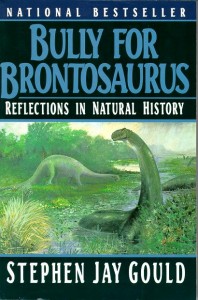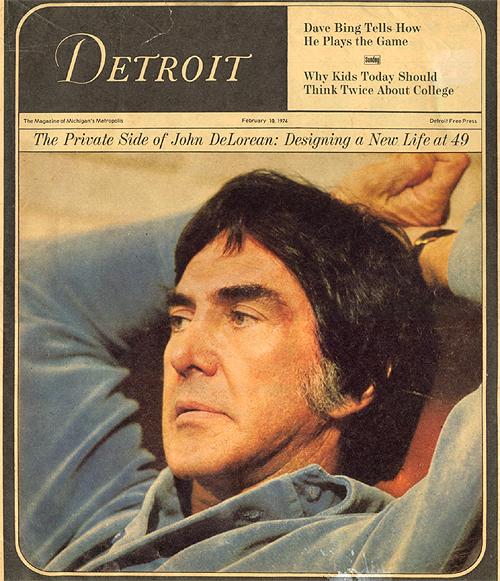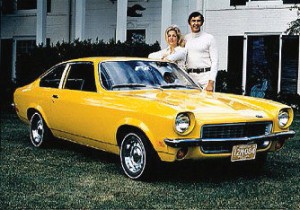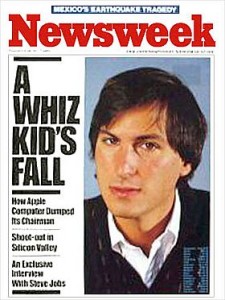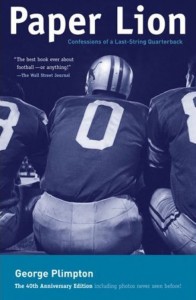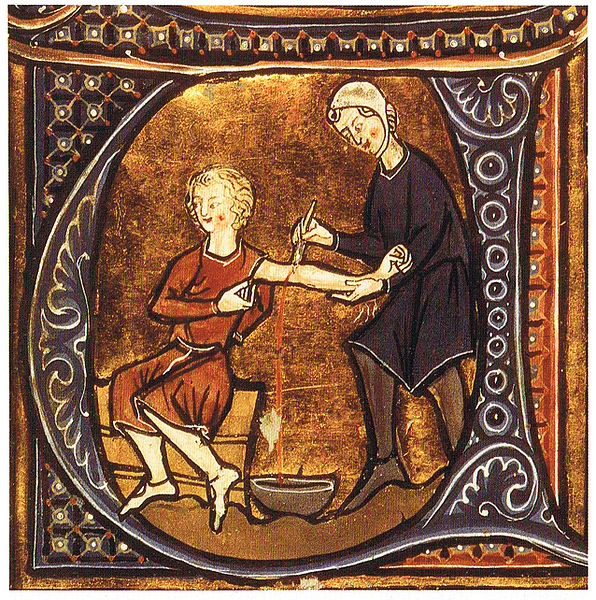Dennis Kucinich interviewed in a Cleveland diner in 1978 by that one-man windstorm Tom Snyder.
You are currently browsing the archive for the Videos category.
Tags: Dennis Kucinich, Tom Snyder
No too many paleontologists make the pages of People magazine, but the late Stephen Jay Gould was a serious academic who crossed over into the mainstream. The Queens-born Harvard professor was a lightning rod for others who disagreed with his theories, but Gould was someone who continually questioned himself, often revising beliefs from early essays in subsequent ones. An excerpt from Michelle Green’s 1986 People profile:
“It is an inviting, vaguely antic enclave that suggests a 19th-century natural history museum turned into a bookish boys’ club. Faded lettering on the drab green walls announces ‘Synopsis of the Animal Kingdom’ and ‘Sponges and Protozoa,’ and in the room’s cluttered depths are a wealth of musty treasures: tall glass cases filled with drawers of trilobites, a towering painting of a tyrannosaurus, hundreds of leather-bound volumes and boxes of snail shells. A worn rattan chair has been pulled up to a worktable that holds fossils, microscopes and a supply of Pepperidge Farm cookies.
Stephen Jay Gould—evolutionary biologist, prolific writer and die-hard Yankees fan—has worked in this office at Harvard’s Museum of Comparative Zoology for 17 years, and many of his books have been spawned here: Ever Since Darwin, The Panda’s Thumb, Hen’s Teeth and Horse’s Toes and now The Flamingo’s Smile (Norton, $17.95). When he arrived with his freshly minted Ph.D. from Columbia, the rumpled, kinetic Gould was an exceptionally promising paleontologist; in the years since, he has become a popular symbol of erudition and scholarship. At 44, he recently completed the final year of a MacArthur Foundation grant that has paid him $38,400 a year since 1981. He was the recipient of an American Book Award in 1981, a National Magazine Award in 1980 and once made the cover of Newsweek. He has done battle with creationists, testified before congressional committees concerning nuclear winter and lectured in South Africa on the history of racism. Students fight to get into his classroom, and assorted crazies send tirades addressed to Mr. Illustrious Historical Professor Jay Gould, University of Harvard.
On this stone-gray afternoon, the illustrious historical professor is finding all the attention a bit of a problem. His secretary is putting through calls approximately every two minutes, and Gould—an ebullient man with a near-perpetual smile—is simultaneously trying to discuss his life’s work and fend off a flood of petitioners. On his desk is the latest batch of correspondence, including a letter from a man who suggests a connection between AIDS and aspirin, and a plea from the husband of a woman who is addicted to Gould’s columns in Discover:: Will the author please send birthday greetings to the following address? This nets the correspondent a hastily scrawled turndown: ‘I am not public property, but a man!'”
Premiere magazine, which published from 1987-2007, offered first-rate reporting about the movie industry for a good, long time, until corporate interference reduced it and destroyed it. One of its last gasps of greatness was “David Lynch Keeps His Head,” David Foster Wallace’s 1996 on set-reportage about the mystifying filmmaker as he made the equally inscrutable Lost Highway. An excerpt:
“The first time I lay actual eyes on the real David Lynch on the set of his movie, he’s peeing on a tree. This is on 8 January in L.A.’s Griffith Park, where some of Lost Highway’s exteriors and driving scenes are being shot. He is standing in the bristly underbrush off the dirt road between the base camp’s trailers and the set, peeing on a stunted pine. Mr. David Lynch, a prodigious coffee drinker, apparently pees hard and often, and neither he nor the production can afford the time it’d take to run down the base camp’s long line of trailers to the trailer where the bathrooms are every time he needs to pee. So my first (and generally representative) sight of Lynch is from the back, and (understandably) from a distance. Lost Highway’s cast and crew pretty much ignore Lynch’s urinating in public, (though I never did see anybody else relieving themselves on the set again, Lynch really was exponentially busier than everybody else.) and they ignore it in a relaxed rather than a tense or uncomfortable way, sort of the way you’d ignore a child’s alfresco peeing.”
••••••••••
Trailer for Lost Highway:
More David Foster Wallace posts:
Tags: David Foster Wallace, David Lynch
Top comment for this video on Youtube: “I wonder what it would look like if you put Piers Morgan through it, feet first.”
Tags: Piers Morgan
John DeLorean remade the automotive industry, remade himself and eventually made a mess.
The opening of “The Private Side of John DeLorean: A New life at 49,” a great 1974 Detroit magazine cover story written by Paul Hendrickson, which profiled the legendary automaker after he exited the corporate car culture to blaze his own trail but before his head-on collision with hubris:
It begins like a parable. A skinny kid from inner-city Detroit grows up in the ’40s playing Slide the Rock and sandlot baseball and sometimes the clarinet. His father is a set-up man at the Ford foundry. His mother, separated from her husband, lives in California.
The boy is crazy for cars, dreaming of them every day as he rides a trolley down Woodward on his way to Cass Tech. Growing like a weed, he enters Lawrence Institute of Technology, graduates in engineering and, in 1948, begins a 25-year career in the automobile industry. Along the way, he picks up two master’s degrees, a wife from northern Michigan and 200 patents, including the recessed windshield wiper, the hidden radio antenna and the overhead-cam engine.
His rise at General Motors in meteoric. In 1965, at age 40, he is made general manager at Pontaic and a vice president. At 44, he becomes the youngest man ever to direct Chevrolet. Three years later, in October, 1972, he is named head of all GM’s car and truck production. His salary, including bonuses, is said to be $650,000. He is most everybody’s odds-on favorite to one day become president.
But here, the story takes a swerve. For by 1972, John Zachary DeLorean was a different breed of cat than the naive, callow youth who entered the business with the conviction that making cars was his calling to help Americans preserve their fifth freedom, mobility. For one thing, he had drastically changed his lifestyle.
He had taken to turtlenecks and tie-dyed blue jeans by then. His weight was down from 235 to just over 170. His hair was long and sculptured and dyed coal-black. There were well-founded stories that he had undergone a face lift. His three-to-four-pack-a-day cigarette habit was gone, as were the suits that came off the rack, as was the first wife. He had also married and divorced actress-model Kelly Harmon, 24 years his junior, and had popped up around the country in the company of Ursula Andress, Nancy Sinatra and Candice Bergen. When in Detroit, he had been known to roar around in such non-GM models as a Lamborghini and a $19,000 Maserati Ghibli. On occasion, he shocked everybody at the office cold by coming to work in a pickup.
He was playing golf with Arnold Palmer and Gary Player, riding motorcycles in the Mojave Desert, chasing girls with one-time auto racer Roger Penske and collecting real estate as if America were his Monopoly board.
In short as Time magazine put it, by 1972 John DeLorean was standing out from his colleagues at GM like a Corvette Stingray or a showroom full of trucks.
But more than any of that, DeLorean by then was just plain disenchanted with his job. He had said at a press conference two years earlier that he did not intend to spend the rest of his life at GM; few believed him.•
John DeLorean’s combustible 1980s, in four videos.
Mesmerizing 17-minute DeLorean DMC-12 prospectus film that was shown to dealers and investors ahead of the automobile reaching the market in 1981.
From Pennebaker and Hegedus in 1981: “John Zachary DeLorean doesn’t smile very much.”
A 1983 California ad offering DeLoreans at the closeout price of $18,895. “This may be your last chance to live the dream.”
In 1988, his dreams dashed and reputation destroyed, DeLorean was living in Manhattan, now a born-again Christian, still believing he would get another chance. He granted a rare interview to a local TV station from his old stomping grounds in Detroit.
Tags: John DeLorean, Paul Hendrickson
Panasonic and eight other companies plan to build the Fujisawa Sustainable Smart Town, the world’s greenest, cleanest community. However, where you live it will still be very filthy. (Thanks Singularity Hub.)
Grantland, Bill Simmons’ new online venture, has a fun oral history about the The National Sports Daily, a star-making and star-crossed newspaper edited by Frank Deford that burned brightly and burned out too soon in the early ’90s. An excerpt about how a Mexican billionaire started the paper on a whim:
“Frank Deford (Editor-in-Chief): I had never heard of Emilio Azcárraga. Very few people had, despite that he was the richest man south of the Rio Grande.
Thom Potraz (Marketing Director): If you went to central casting and asked for a “Mexican Billionaire,” they’d give you Azcárraga.
Dave Kindred (Associate Editor; National Columnist): They called him … El Tigre.
Peter Price (Publisher): It all started in the spring of 1989. Azcárraga wanted to have lunch. I’d heard about Emilio from Televisa, the Mexican media conglomerate, because I was in the media business, as well. I’d become publisher of the New York Post when Peter Kalikow bought the paper from Rupert Murdoch for $37 million. When I took over in 1988, there was a strike going, the circulation had plummeted, and the advertising had disappeared. We had the challenge of rebuilding. At lunch, Azcárraga started one of the strangest conversations of my life.
Emilio Azcárraga (Died in 1997. Lunch conversation recalled by Price): I read a comment of yours that the Post is unique among all American dailies in that it has many more male readers than female readers. You attributed that to the fact that the Post was a newspaper for women and a sports paper for men.
Price: The ladies like our gossip; the guys read it backwards and hardly ever get to the front of the newspaper.
Azcárraga: That’s what I want to talk to you about! Why is it that the most developed country in the world doesn’t have a daily sports newspaper? We’ve got one in Mexico. The Italians have two. The Brits have tabloid sports papers. L’equipe in France is reigning strong, and Japan has a sports paper.
Price: There are only three national newspapers in the United States, and only one is a purely national paper with genuinely national distribution. But USA Today is going on almost a decade, a billion dollars in losses, and it’s supported by a major publishing company. To do a national sports paper from scratch without the backing of a major publishing enterprise, without having a delivery system, without having regional printing plants, without having a brand name, and without any staff is not for the fainthearted.
Azcárraga: I think it’s a good idea. What would it take? Why don’t you give that some thought and come down and visit me? I’ll send my plane.”
••••••••••
Deford, Roger Angell and George Will discuss baseball’s home-run explosion in 1998 with Charlie Rose, whose head resembles a catcher’s mitt:
Another Frank Deford post:
Tags: Bill Simmons, Frank Deford
Portrait from 1965 of Leonard Cohen at age 30. Dark but not yet bitter.
Tags: Leonard Cohen
R. Luke Dubois posted “The First Computer Musician,” an excellent piece about Max Mathews, for the Opinionator on the New York Times site a couple days ago. Mathews, a pioneer of wired music, passed away in April. The opening:
“In 1957 a 30-year-old engineer named Max Mathews got an I.B.M. 704 mainframe computer at the Bell Telephone Laboratories in Murray Hill, N. J., to generate 17 seconds of music, then recorded the result for posterity. While not the first person to make sound with a computer, Max was the first one to do so with a replicable combination of hardware and software that allowed the user to specify what tones he wanted to hear. This piece of music, called “The Silver Scale” and composed by a colleague at Bell Labs named Newman Guttman, was never intended to be a masterpiece. It was a proof-of-concept, and it laid the groundwork for a revolutionary advancement in music, the reverberations of which are felt everywhere today.
When Max died in April at the age of 84 he left a world where the idea that computers make sound is noncontroversial; even banal. In 2011, musicians make their recordings using digital audio workstations, and perform with synthesizers, drum machines and laptop computers. As listeners, we tune in to digital broadcasts from satellite radio or the Internet, and as consumers, we download small digital files of music and experience them on portable music players that are, in essence, small computers. Sound recording, developed as a practical invention by Edison in the 1870s, was a technological revolution that forever transformed our relationship to music.”
••••••••••
A bit of Mathews’ “Phosphones”:
Tags: Max Mathews, R. Luke Dubois
From “6 Products That Became Technology Roadkill“: “Back in 1987, GO Corporation was on the vanguard of pen-based computing, and investors handed the enterprise $75 million to make the world eschew the keyboard and mouse. In 1991, GO released its OS, PenPoint, designed specifically for the new market and it included gesture recognition. Not only was GO’s technology well received, but also it was implemented in several IBM computers, including the first ThinkPad.”
••••••••••
“The Woodstock of pen-based computing”:
The perfect opening of “Shipping Out,” David Foster Wallace’s 2004 Harper’s reportage about the enforced happiness of the luxury-cruise industry, which was subsequently retitled, “A Supposedly Fun Thing I’ll Never Do Again”:
“I have now seen sucrose beaches and water a very bright blue. I have seen an all-red leisure suit with flared lapels. I have smelled suntan lotion spread over 2,100 pounds of hot flesh. I have been addressed as ‘Mon’ in three different nations. I have seen 500 upscale Americans dancing the Electric Slide. I have seen sunsets that looked computer-enhanced. I have (very briefly) joined a conga line.
I have seen a lot of really big white ships. I have seen schools of little fish with fins that glow. I have seen and smelled all 145 cats inside the Ernest Hemingway residence in Key west, Florida. I now know the difference between straight bingo and Prize-O. I have seen fluorescent luggage and fluorescent sunglasses and fluorescent pince-nez and over twenty different makes of rubber thong. I have heard steel drums and eaten conch fritters and watched a woman in silver lamé projectile-vomit inside a glass elevator. I have pointed rhythmically at the ceiling to the two-four beat of the same disco music I hated pointing to the ceiling to in 1977.
I have learned that there are actually intensities of blue beyond very bright blue. I have eaten more and classier food than I’ve ever eaten, and done this during a week when I’ve also learned the difference between ‘rolling’ in heavy seas and ‘pitching’ in heavy seas. I have heard a professional cruise-ship comedian tell folks, without irony, ‘But seriously.’ I have seen fuchsia pantsuits and pink sport coats and maroon-and-purple warm-ups and white loafers worn without socks. I have seen professional blackjack dealers so lovely they make you want to clutch your chest. I have heard upscale adult U.S. citizens ask the ship’s Guest Relations Desk whether snorkeling necessitates getting wet, whether the trapshooting will be held outside, whether the crew sleeps on board, and what time the Midnight Buffet is.”
••••••••••
In 1986, Wallace, Jonathan Franzen and Mark Leyner discuss literature in the Information Age with that handsome, world-weary robot Charlie Rose:
Tags: Charlie Rose, David Foster Wallace, Jonathan Franzen, Mark Leyner
Two excerpts from Steve Jobs’ 1985 Playboy interview, including one in which the Apple visionary predicts his leaving the company and returning to it even stronger, without realizing his departure would be involuntary.
••••••••••
“Playboy: Obviously you believe that computers are going to change our personal lives, but how could you persuade a skeptic? A holdout?
Steve Jobs: A computer is the most incredible tool we’ve ever seen. It can be a writing tool, a communications center, a supercalculator, a planner, a filer and an artistic instrument all in one, just by being given new instructions, or software, to work from. There are no other tools that have the power and the versatility of a computer. We have no idea how far it’s going to go. Right now, computers make our lives easier. They do work for us in fractions of a second that would take us hours. They increase the quality of life, some of that simply by automating drudgery and some of that by broadening our possibilities. As things progress, they’ll be doing more and more for us.”
••••••••••
“Jobs: I’ll always stay connected with Apple. I hope that throughout my life I’ll sort have the thread of my life and the thread of Apple weave in and out of each other like tapestry. There may be a few years when I’m not there, but I’ll always come back. And that’s what I may try to do. The key thing to remember about me is that I’m still a student. I’m still in boot camp. If anyone is reading any of my thoughts, I’d keep that in mind. Don’t take it all too seriously. If you want to live your life in a creative way, as an artist, you have to not look back too much. You have to be willing to take whatever you’ve done and whoever you were and throw it away, What are we anyway? Most of what we think we are is just a collection of likes and dislikes, habits, patterns. At the core of what we are is our values, and what decisions and actions we make reflect those values. That is why it’s hard doing interviews and being visible. As you are growing and changing, the more the outside world tries to reinforce an image of you that it thinks you are, the harder it is to continue to be an artist, which is why a lot of times artists have to go, ‘Bye, I have to go. I’m going crazy and I’m getting out of here.’ And they go and hibernate somewhere. Maybe later they re-emerge a little differently.”
••••••••••
Before Hodgman vs. Long, Dick Cavett was the Apple pitchman. From 1981:
Tags: Steve Jobs
If your family isn’t of the extended variety, there is an answer for your needs at the Rent-a-Grandma site:
“Rent-A-Grandma is your one stop agency for all your quality domestic staffing needs. Our Grandmas are carefully screened mature (age 50+) women who are only the most professional, experienced staff and meet the standards you will demand for own ‘Grandma.’ Rent-A-Grandma sets a standard unequaled in the industry. Our agency carefully screens and background checks each applicant.
You can trust our Grandmas. Plus, our Grandmas don’t text or tweet while they are watching your kids!
Our Rent-A-Grandmas are:
- Carefully screened
- English speaking
- Most have decades of experience in childcare and providing household services
- Loyal & committed
- Why hire a teenage nanny when you can have a Grandma?”
From Singularity Hub: “Ever since True Lies I’ve been waiting for an affordable pair of spy glasses that can transmit video in real time. My wait looks like it may be over very soon. Seattle startup ZionEyez is building momentum to launch their Eyez video recording glasses this year. The Roy Orbison looking Eyez will feature a 720p HD recording camera, microphone, Bluetooth and WiFi connectivity, 8 GB flash memory, and three hours of battery life. Using an iPhone or Android app you can transmit what your Eyez record directly to the web.”
This is your life now. Work is scarce so you do what you must when you’re told to. You work the graveyard shift (if you’re lucky enough to be offered it). But what if you can’t stay energetic in the middle of the night? What if you work during the daylight hours but spend half the night digesting your computer screen, trying to keep up with the flow of information, keeping track of the other you? How can you summon the strength? For an age like ours, there’s Nuvigil, a stimulant for “shift work disorder” from the good people at Cephalon. Side effects include (no joke): life threatening allergic reaction, skin rashes, chest pain, dark urine, depression, anxiety, hallucinations, psychosis, mania, thoughts of suicide, aggression, and other mental problems, headache, nausea, dizziness, and trouble sleeping. It costs $300 a month. You will pay.
Adam Curtis’ silicon-phobic BBC documentary series, which takes its title from Richard Brautigan’s great poem.
Tags: Adam Curtis, Richard Brautigan
Dick Cavett queries Jean-Luc Godard in 1980. Both were past-peak but smart.
Paleontologist Jack Horner, who wants to use genetic advances to create a living dinosaur so that we can all know the thrill of death by dinosaur, presented this new TED Talk about his Chickensauraus.
Tags: Jack Horner
I interviewed George Plimpton shortly before his death, though I accept no blame for his demise. In 1966, the journalist, editor, party maven and prankster scored one of his greatest successes with Paper Lion, a sports book about trying out for third-string quarterback for the Detroit Lions. The other players weren’t in on the lark, though they soon came to realize the 36-year-old rookie was better at throwing back martinis than throwing tight spirals. The book grew out of “Zero of the Lions,” the author’s famous 1964 Sports Illustrated article. An excerpt from that piece:
“I looked for my helmet, relieved to see it lying in the grass a few yards away. My impulse was to put it on. From the beginning I’d had trouble getting into the helmet. The procedure was to stick the thumbs in the helmet’s ear holes and stretch the helmet out as it came down over the head—a matter of lateral pull, and easy enough if you practiced isometrics, but I never had the strength to get my ears quite clear, so they were bent double inside the helmet once it was on. I would work a finger up inside to get the cars upright again, a painful procedure, and noisy, the sounds sharp in the confines of the hard shell of the helmet as I twisted and murmured until it was done, the ears ringing softly. Then quiet would settle in the helmet, and I would look out beyond the bars of the nose guard—the ‘cage,’ the players call it—to see what was going on outside, my eyes still watering slightly. It was even more difficult to get the helmet off. The first helmet Friday Macklem had given me was too small—a helmet is supposed to fit snugly to afford the best protection—and when I tried it on in front of my locker I yelled as it came down over my ears. Wayne Walker, the big linebacker, happened to be chatting with me at the time.
‘How’d she feel?’
‘Feels fine. Snug,’ I said. ‘Once you get the thing on.’
I tried to take it off. I got my thumbs in the ear holes and tried to budge the helmet loose.
‘I’m stuck in here,’ I said, simply.
Walker began to grin. He looked down the locker room aisle for other players who would have enjoyed the dilemma. Mercifully, none were on hand.
‘Damn!’ I said. ‘I can’t budge this thing.'”
••••••••••
Plimpton parlayed his Paper Lion success into Oldsmobile Vista Cruiser ads:
Tags: George Plimpton
An excerpt (via Wired) from The Red Market, Scott Carney’s horrifying account of contemporary flesh peddlers of all sorts, including an Indian farmer who holds people captive and “milks” them for blood which is sold for profit:
“For the last three years the man had been held captive in a brick-and-tin shed just a few minutes’ walk from where the farmers were drinking tea. The marks on his arms weren’t the tell-tale signs of heroin addiction; they came from where his captor, a ruthless modern-day vampire and also a local dairy farmer and respected landowner named Papu Yadhav, punctured his skin with a hollow syringe. He had kept the man captive so he could drain his blood and sell it to blood banks. The man had managed to slip out when Yadhav had forgotten to lock the door behind him.
The emaciated man brought the officers to his prison of the last three years: a hastily constructed shack sandwiched between Papu Yadhav’s concrete home and a cowshed. A brass padlock hung from the iron door’s solid latch. The officers could hear the muffled sounds of humanity through the quarter inch of metal.
They sprung the lock and revealed a medical ward fit for a horror movie. IV drips hung from makeshift poles and patients moaned as if they were recovering from a delirium. Five emaciated men lying on small woven cots could barely lift their heads to acknowledge the visitors. The sticky air inside was far from sterile. The sun beating down on the tin roof above their heads magnified the heat like a tandoor oven. One man stared at the ceiling with glassy eyes as his blood snaked through a tube and slowly drained into a plastic blood bag on the floor. He was too weak to protest.”
Tags: Papu Yadhav, Scott Carney
Casablanca went through an astounding number of writers and directors, somehow becoming an all-time classic against all odds. In 1971, Ingrid Bergman recalled the turmoil for an interviewer whose hair was subsequently declared a sovereign nation.
Tags: Ingrid Bergman
From “My Dealing, Stealing, Squealing Neighbors,” a recent New York magazine piece by the excellent Luc Sante about his years living in Manhattan tenements:
“The task of holding the house together fell on the super, a man named Zygmunt, whom everyone called George. He lived in the first apartment on the right as you came in, was usually available—except on Sunday mornings, when his hangover took precedence—and was a dab hand with a pipe wrench. He did commendable work under the circumstances, although he never was able to fix the bathtub of Rose and Simon, my neighbors across the hall, with the result that they came over to use mine a few times a week for the entire term of my residence.
By and large, I loved my neighbors, although I worried constantly, owing to the presence of so many loose cannons in a single fragile container. One afternoon I took myself out to the movies. Film Forum was showing the last picture directed by Erich von Stroheim, which he called Walking Down Broadway although it ended up as Hello, Sister! It contained a subplot about a construction worker who, after getting plowed at the saloon across the street from his work site every night, would sneak back in and steal a few sticks of dynamite, which he’d throw under his bed when he got home. In the third act, naturally, nature took its course. I walked home thinking about how such a character would not be out of place in my building. Then when I opened the door I beheld my neighbors, all of them, out in the halls, rushing around with buckets of water. We had very narrowly escaped a conflagration.
It seemed that the art critic on the fourth floor had become immersed in crack to the extent that he had neglected to pay his Con Ed bill. His service cut off, he had been lighting his way with candles, although he was perhaps not as attentive as the situation might warrant. Furthermore, his apartment contained several years’ worth of newspapers, as well as a small fortune in contemporary oil paintings. Nature had taken its course.”
••••••••••
Luc Sante collects postcards:
More Luc Sante posts:
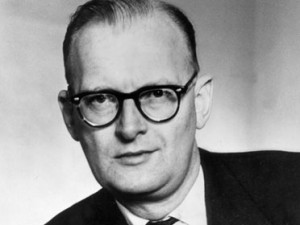 Two excerpts from Arthur C. Clarke’s 1986 Playboy interview.
Two excerpts from Arthur C. Clarke’s 1986 Playboy interview.
••••••••••
“PLAYBOY: You’ve said that the famous opening sequence, in which the bone thrown into the air by the prehistoric man-apes becomes the space vehicle Discovery, came about by accident.
CLARKE: Yes, Stanley and I were trying to figure out that crucial transition. We were walking back to the studio in London and, for some reason, Stanley had a broomstick in his hand. He threw it up into the air, in a playful way, and he kept doing it, and it was at that moment that the idea of making the broomstick into the bone that gets turned into Discovery came about. I was afraid it was going to hit me in the head. [Laughs] So later we filmed it with some sort of bone. That shot was the only one in the movie done on location. It was shot just outside the studio. There was a platform built and, just beneath it, all the London buses were going by.”
••••••••••
“PLAYBOY: In the postscript to your book Ascent to Orbit, you talk about technology quite a bit. You have a lot of technology in your own home—your John Deere computer “Archie,” your satellite dish, your Kaypro-II computer. Yet you write, “This power over time and space still seems a marvel to me, even though I have been preaching its advent for decades. But the next generation will take it completely for granted and wonder how we ever managed to run the world without it … which we never did. May these new tools help them to succeed where we failed so badly.” Do you still think that way?
CLARKE: [Pauses] Absolutely. That’s why I’m so delighted that kids these days are not using their computers strictly to play games but are using them to process information. Knowledge really is power, and computer technology has increased an individual’s potential for power considerably. I still think it’s one’s duty to be optimistic about the possibilities of that power, without being unrealistic. It’s just that if one radiates doom and gloom about the possibilities of technology, one is in danger of creating a self-fulfilling prophecy about self-destruction.”
••••••••••
Bone becomes spaceship:
More Arthur C. Clarke posts:
Tags: Arhtur C. Clarke, Stanley Kubrick
The shit-kicking (and shit-eating!) Divine visited that bombastic chucklehead Tom Snyder in 1979. Also on hand: Warhol superstar Holly Woodlawn.
From Divine’s 1988 obituary in the Times of London: “Divine, the 21-stone drag artist who has died in Los Angeles at the age of 42, won a cult following through his appearances in American underground films.
Once voted ‘the filthiest person alive,’ Divine built his reputation on the ability to shock. But it was, he claimed, part of a calculated assault on what he saw as American materalism and hypocrisy.
He always disliked being labelled a transvestite and insisted that cha-cha heels and thigh-splitting spandex dresses were purely ‘work clothes’ designed to make people laugh.
He was born Harris Glen Milstead and started his career as a hairdresser in Baltimore, Maryland. The film director John Waters, who had been at school with him, devised his professional name.
Made during the 1970s, the Waters/Divine films were deliberately raucous, crudely made and sexually explicit but achieved a critical respectability as a searing portrait of a sick society. They included Desperate Living, a tale of rape, murder and cannibalism, and Female Trouble, in which Divine played a delinquent schoolgirl who is violated by a struck driver and ends up in the electric chair.”
Tags: Divine, Harris Glen Milstead, Holly Woodlawn, John Waters, Tom Snyder
Entertaining putz Tom Snyder hectors Ayn Rand in 1979.
Tags: Ayn Rand, Tom Snyder

